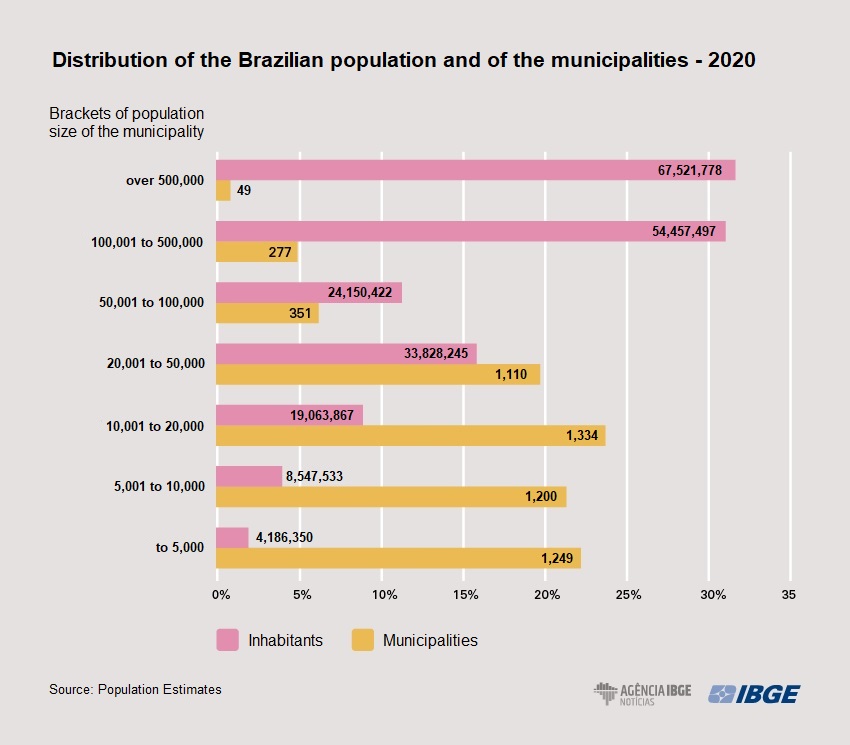2020 Estimates
IBGE estimates Brazilian population at 211.8 million inhabitants
August 27, 2020 09h00 AM | Last Updated: August 28, 2020 03h42 PM
Highlights
- São Paulo remains as the most populated municipality, with 12.3 million persons.
- With only 776 inhabitants, Serra da Saudade (MG) is the less populated Brazilian city.
- 21.9% of the population is concentrated in 17 municipalities, all of them with more than one million inhabitants, being 14 state capitals.
- In 2020, 49 municipalities had more than 500 thousand inhabitants.
- The group of municipalities with up to 20 thousand inhabitants proportionally showed the largest number of municipalities with a reduction in the population (1,410 or 37.3%) (37,3%).
- The municipalities between 100 thousand and one million inhabitants are those with the largest contingent of municipalities growing above 1%, adding up to 142 (46.0%).
- 28.1% of the municipalities (or 1,565 cities) reduced their population, whereas only 205 municipalities (3.7% of the total) grew equal to or above 2%.
 Metropolitan Areas, like Rio de Janeiro, have growing rates below the country average - Photo: IBGE Archive
Metropolitan Areas, like Rio de Janeiro, have growing rates below the country average - Photo: IBGE ArchiveAccording to the Population Estimates released today (27) by the IBGE for the 5,570 municipalities, Brazil reached 211.8 million inhabitants in 2020, growing 0.77% over last year. With a reference date of July 1st, the study shows that 21.9% of the population is concentrated in 17 municipalities, all of them with more than one million inhabitants, being 14 of them state capitals.
The municipal population estimates are one of the parameters used by the Brazilian Court of Audit to calculate the State and Municipal Revenue Sharing Fund and are key to compute a number of social, economic and demographic indicators.
The municipality of São Paulo remained as the most populated, with 12.3 million inhabitants, followed by Rio de Janeiro (6.75 million), Brasília (3.05 million) and Salvador (2.88 million). Adding up to only 776 inhabitants, Serra da Saudade (MG) is the Brazilian city with the smallest population.
In the last decade, the estimates point out a gradual increase in the number of large municipalities in Brazil. In the 2010 Census, only 38 cities had a population above 500 thousand inhabitants and 15 of them had more than one million residents. In 2020, the Brazilian municipalities with more than 500 thousand inhabitants added up to 49, being 17 of them with more than one million inhabitants.
"The figures follow a trend already perceived over the last years, highlighting the emergence of regional poles, which show a population growth above 1% per year," explains Márcio Mitsuo Minamiguchi, IBGE´s manager of Population Estimates and Projections.
The growth rates were negative in 28.1% of the municipalities (or 1,565 cities), i.e., the population was reduced. Slightly more than half of the Brazilian municipalities (52.1%) had a population growth between zero and 1%. Only 205 municipalities (3.7% of the total) had a growth equal to or above 2%.
The North and Central-West recorded the highest proportions of municipalities with growth rates above 1%. In the South Region, 45.6% of the municipalities reduced their population.

Regional poles have proportion of municipalities with population growth above 1%
The group of municipalities with up to 20 thousand inhabitants proportionally posted the greatest number of municipalities with population reduction (1,410 municipalities or 37.3%). On the other hand, the group between 100 thousand and one million inhabitants is the one that has the highest percentage of municipalities with a growth above 1%, adding up to 142 (46.0%). Cities with more than one million inhabitants grew between 0 and 1% per year (14 out of the 17 municipalities).
The data reinforce the perception that the small municipalities are losing residents, whereas the medium ones grow – at the same time that the largest cities are stabilized in terms of population growth. "As the large towns are unable to expand and provide housing for all, it is natural that new families look for peripheral areas, improving the attractiveness of the regional poles," highlights Minamiguchi.
This phenomenon is also reflected in the estimates related to the Metropolitan Areas. The growth rates of the largest metropolitan areas in Brazil (São Paulo, Rio de Janeiro, Belo Horizonte, Porto Alegre, Fortaleza, Recife and Salvador) are slightly lower than the country average. In those metropolis, the growth of the capital is, in most cases, lower than that reported in the remaining municipalities.
In the ranking of the states, São Paulo remains as the most populated, with 46.3 million inhabitants, concentrating 21.9% of the total Brazilian population, followed by Minas Gerais (21.3 million inhabitants) and Rio de Janeiro (17.4 million). The five less populated states, which add up to 5.7 million persons, are all in the North Region: Roraima, Amapá, Acre, Tocantins and Rondônia.




















